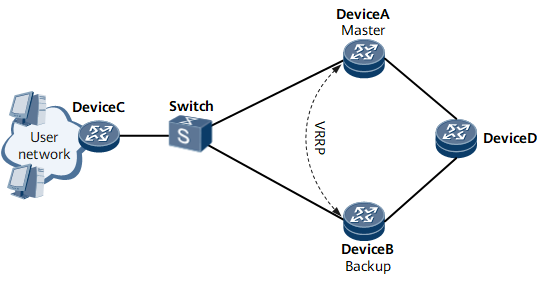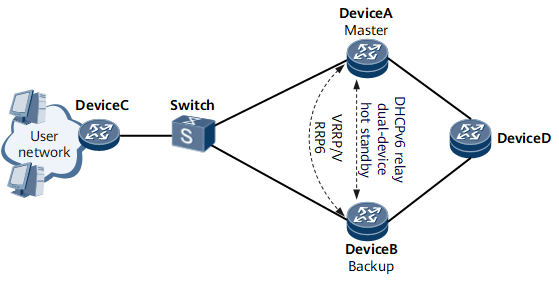DHCPv6 Relay Dual-Device Hot Standby
Networking Description
DHCPv6 relay dual-device hot standby effectively implements rapid service switching by keeping user session information synchronized on the master and backup devices in real time on the control and forwarding planes. The user session information (including the user DUID, MAC address, IPv6 address, and lease) generated during user access from the master device is synchronized to the backup device. When VRRP detects a link failure on the master device, a VRRP packet is sent to adjust the priority, triggering a master/backup VRRP switchover. After the master/backup VRRP switchover is performed, the original backup device takes over to provide user address assignment, lease renewal, and data packet forwarding. Users are not aware of DHCPv6 relay agent switching.
Figure 1 shows the typical network with a VRRP group deployed. DeviceA and DeviceB are the master and backup devices, respectively. Both DeviceA and DeviceB are DHCPv6 relay agents that process address assignment and lease renewal requests. DeviceC and DeviceD function as the DHCPv6 client and server, respectively. In normal situations, DeviceA processes DHCPv6 users' login and lease renewal requests. In addition, DeviceA generates prefix routes based on the PD prefixes assigned by DeviceD to DeviceC, and advertises the prefix routes to the network. DeviceD can then obtain the information about the routes to DeviceC and its connected user terminals, so that the user terminals can access the network normally.
If DeviceA or the link between DeviceA and the switch fails, a master/backup VRRP switchover is performed. DeviceB then becomes the master. DeviceD can access the user terminals connected to DeviceC only after DeviceB synchronizes DeviceA's PD prefix routes and advertises the prefix routes to the network.
Feature Deployment
If DeviceA or the link between DeviceA and the switch fails, new users cannot go online and the existing online users cannot renew their leases. To resolve this issue, configure DHCPv6 relay dual-device hot standby on DeviceA and DeviceB.
On the network shown in Figure 2, after DHCPv6 relay dual-device hot standby is configured on DeviceA and DeviceB, DeviceB synchronizes DHCPv6 PD user information from DeviceA in real time and generates PD prefix routes. If a master/backup VRRP switchover is performed, DeviceD can access the user terminals connected to the DeviceC through the PD prefix routes on DeviceB.

